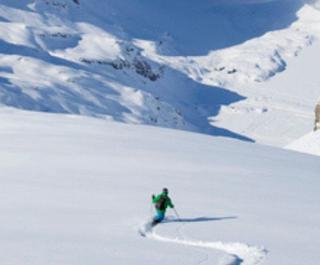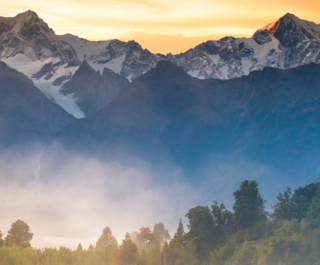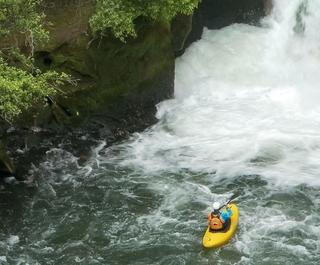
Go ahead, sink your toes in the sand on Hawaii's famous beaches. But you might be surprised by the colour of that sand – it's not always golden. You'll find black sand, red sand and even green sand across the island chain.
The Big Island, Maui and Molokai offer black sand beaches. Maui is home to a red beach, and the Big Island is home to a green beach, both rare and off the beaten path. While common golden sand is made up of small pieces of coral and seashells broken up by ocean waves over time, the more unusual colors found around Hawaii's beaches can be traced to volcanoes.
Black sand beaches are formed "when hot molten lava enters the cold ocean and is immediately quenched to solid glass, then shatters from the resulting steam", says Darcy Bevens at the Center for the Study of Active Volcanoes at the University of Hawaii at Hilo.
Maui's Kaihalulu Bay red sand beach is coloured by the crumbling volcanic red cinder cliffs that surround the bay, she said, while the green sand on the Big Island's Papakolea Beach is from olivine crystals from an eroding volcanic cinder cone.
Make the most of Hawaii's natural beauty: Hidden Hawaiian Gems
Overcome by the romance of the islands? Get Hitched In Hawaii
A Black Sand Beach 25 Years Old
A new black sand beach was formed on the eastern shores of the Big Island after lava from the Kilauea volcano engulfed the town of Kalapana in 1990, destroying most of the homes. The molten lava also filled in Kaimu Bay, covered the beach that was there, and extended the shoreline, creating a new beach about half a kilometre from the original. Locals began cultivating a grove of coconut trees at the new beach as soon as the lava cooled.
Today a small visitor's centre at the beginning of the beach trail displays pictures of the area before the disaster. It takes 10 to 20 minutes on the trail, through the lava field, to reach the ocean. Don't go too far off the trail, as the lava field can be tough to navigate and the region still has active lava flows.
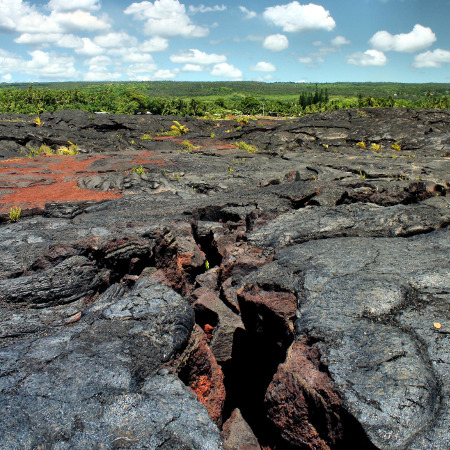 A fissure in the lava flow at Kaimu Beach in Hawaii. Picture: Getty Images
A fissure in the lava flow at Kaimu Beach in Hawaii. Picture: Getty Images
The beach sits below an eroding lava plateau and strong, white waves rumble across the black lava rock face. Swimming is not recommended, as the waves and current are treacherous, but the views are unmatched. And knowing the beach is only 25 years old is mind-blowing – it's younger than some of its visitors.
The new Kaimu Beach is at the end of Highway 130, past Pahoa town, where the road meets Highway 137. There is adequate parking. Vendors sell fruit smoothies, barbecue lunch plates and souvenirs. Check with local authorities before going, as active lava flows may disrupt access.
Red Sand, Nude Bathers
Kaihalulu Bay on Maui near the town of Hana is home to a unique red sand beach. Towering red cinder cliffs surround the bay, and the blue ocean swirls along the red sandy shore.
A large lava rock reef juts out in the bay, slightly protecting the beach from harsh waves but swimming is not advised. There are no lifeguards and ocean conditions are unpredictable.
This is one of Hawaii's few nude beaches due to the cove's isolation, so don't be surprised by the clothing-optional scene. And getting there isn't easy. You must cross private property to get to the trail to the beach, so you'll need permission from landowners. In addition, the narrow trail is slippery and unstable. Many locals and visitors go there daily, but be careful.
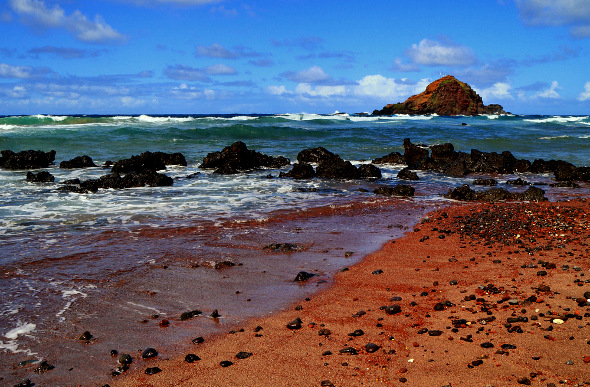 Hamoa's salt-and-pepper beach on Maui.
Hamoa's salt-and-pepper beach on Maui.
If that's too daunting, an alternative is Hamoa Beach, just down the road from Hana. Hamoa's unique salt-and-pepper beach – a mix of black and white sand – has been voted one of Maui's most popular beaches.
To reach Hana, take Highway 360, also known as Hana Highway, from the main town of Kahului. The popular drive offers switchbacks, waterfalls and scenic views.
Green Sand On Big Island
Back on the Big Island is the Papakolea green sand beach, surrounded by olive-colored cliffs and crashing surf. Olivine crystals eroding from an ancient volcanic cinder cone give Papakolea its hue.
Papakolea Beach is located near the Big Island's southernmost point. Beach-goers have to shimmy down the side of the cinder cone on a worn trail to the beach.
The sand itself is not as vibrant as some patches of green you'll find outside on the trail leading to the beach. There are no lifeguards, so swim with caution.
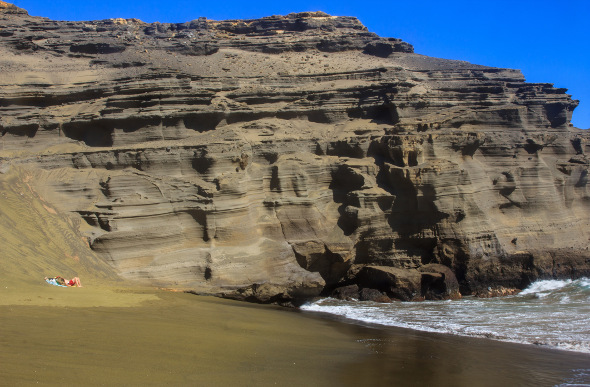 The sand of Papakolea has a subtle green tinge that grows and fades. Picture: Getty Images
The sand of Papakolea has a subtle green tinge that grows and fades. Picture: Getty Images
To get there, drive to the end of South Point Road via Highway 11 to a dirt parking lot. From there it's an hour hike (each way) through a lava field to a worn dirt road to the beach.
Sturdy shoes and drinking water are essential. The route offers scenic views, ancient Hawaiian structures and patches of emerald green sand.
Locals may offer rides for $15-$20 in 4X4s, but they're not legally permitted, so go at your own risk.
Take nothing but pictures
It's illegal to remove sand from Hawaiian beaches – whether green, red, black or golden.
This article was written by Marco Garcia from The Associated Press and was legally licensed through the NewsCred publisher network.


